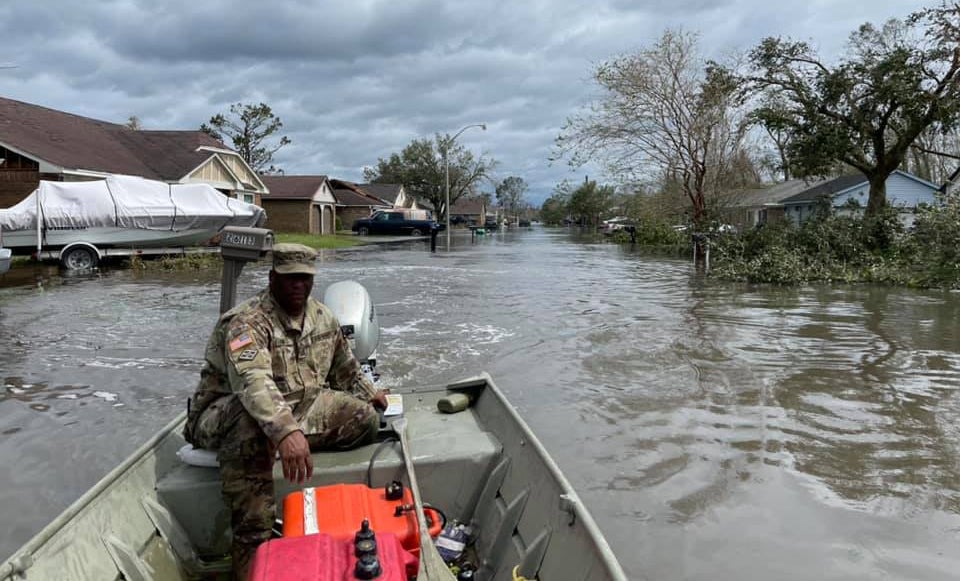WCP: Class and Water: Climate-Charged Displacement

Posted in News Working-Class Perspectives | Tagged Ken Estey
Climate change threatens all of us, but it is already having — and will continue to have — especially powerful effects on working-class people and communities. In Working-Class Perspectives this week, Ken Estey focuses on the recent example of Hurricane Ida’s impact on one Louisiana community where many residents remain without housing weeks after the storm. As he writes, the combination of our reliance on fossil fuels and refusal to fund infrastructure projects makes the region vulnerable, now and in the future.
Hurricane Ida in Louisiana in August and the historic wildfires in the West and Midwest are the latest reminders that too much water, or too little, will be in the headlines for the rest of our lives. But to call these reminders merely “natural disasters” mystifies the class-relations that structure the built environment. The economically vulnerable are the first to suffer and the last to recover.
Terrebonne Parish in Louisiana, home to oil-industry, seafood, and tourism jobs, lost 10,000 homes. Ten weeks after the hurricane, FEMA will finally deliver mobile homes in mid-November. On October 4, Louisiana opened its Hurricane Ida Sheltering Program to ship mobile homes while it waits on the federal government. Instead, it will probably deliver recreational vehicles, travel trailers and crew barges for temporary housing. Hurricanes and climate-induced disasters reveal the sharp class differences that dictate who will survive and who will perish.
Hurricane Ida’s devastation of the Louisiana coast is only the beginning of what to expect in the coming years. Just last week, the World Meteorological Organization (WMO, United Nations) released its 2021 State of Climate Services: Water. The forecast is foreboding and it makes clear that the repeated devastation of Louisiana’s coastal working-class communities is just one part of a global disaster. The WMO reports that two billion people are suffering water stress or an unsustainable imbalance of freshwater withdrawal and total available freshwater resources. 3.6 billion people now face inadequate access to water for at least one month per year and by the year 2050, this number is projected to increase to more than five billion. As in the past, the water inadequacies fall heavily on the poor and working class.
Ready access to water, suitable for drinking and washing, is a vital but often neglected topic in climate change discussions. Moreover, responses to global warming such as climate change adaptation, and managing water resources often ignores the disproportionate impact on working-class communities.
According to 2021 State of Climate Services: Water, most countries have started to implement water resource management yet 107 countries remain behind in building the necessary infrastructure to deal with storms such as Hurricane Ida. To meet targets set for 2030, the current rate of progress toward full “Integrated Water Resources Management” would need to be quadrupled at a time when 2.3 billion people lack basic hygiene services. The United States is clearly behind in its public investment to manage water resources and demonstrably lacks the capacity to adequately and speedily meet the needs of communities overwhelmed by flooding.
The risk of delay or inaction on building infrastructure to conserve and manage water is increasing. In the last two decades, flood-related disasters have increased by 134% (compared with 1980 to 1999) and the number and duration of droughts by 29%. Increasingly frequent drought-related disasters have affected 1.43 billion people and promises additional misery and immiseration in the years ahead mostly in the least developed countries.
The 2021 State of Climate Services: Water offers an informative survey of water resources by region, but it does not analyze why infrastructural improvements to water resources are so difficult to attain. It mentions “Least Developed Countries” to signal differences among countries in attainable infrastructural spending. But it does not discuss differences within countries – differences that make clear that resources are not allocated equally. Even in countries with “good” infrastructure, working-class communities often lack resources.
Terrebonne Parish is one example. After Ida, power was down for a nearly a month. As one resident succinctly summed up the situation: “No water, no electricity, so you can’t do nothing.” In the face of 150 mph winds, it is little surprise the power went out. But for a month? In nearly LaPlace, water has yet to recede from the hurricane. Flood-water management is plainly a key infrastructural matter, and so is the resilience of the electrical grid — or better yet, a complete reconceptualization of the delivery of power.
President Biden’s increasingly embattled $3.5 trillion plan includes massive investments in necessary climate change infrastructure. But such efforts face other challenges, including seemingly unstoppable wealth transfers to economic elites and brazen thievery of public money. Given that some of this hoarded money is directly related to oil industry profits, getting that money back to pay for the damage and wean ourselves off fossil fuels is not only a common good but common sense.
Yet some workers worry about the economic costs of such a shift. When the French named Terrebonne “Good Water,” they probably didn’t foresee the economic boon of the region’s offshore oil and gas industry. Workers settled there to build that industry and join existing fishing communities. And now workers face the cruel contradiction of this oil industry economy: the working-class jobs that built modern Terrebonne Parish now threaten to undo it. The combined threat of too much flood water and too little fresh water is too much to bear for many people. Some are wondering whether to call it quits.
Rebuilding Terrebonne Parish and nearby coastal communities is not only about building back better but building back differently. The ever-increasing challenges caused by coastal flooding and the need to ensure adequate freshwater supplies means that jobs focused on rebuilding will be permanent.
Ken Estey, Brooklyn College
